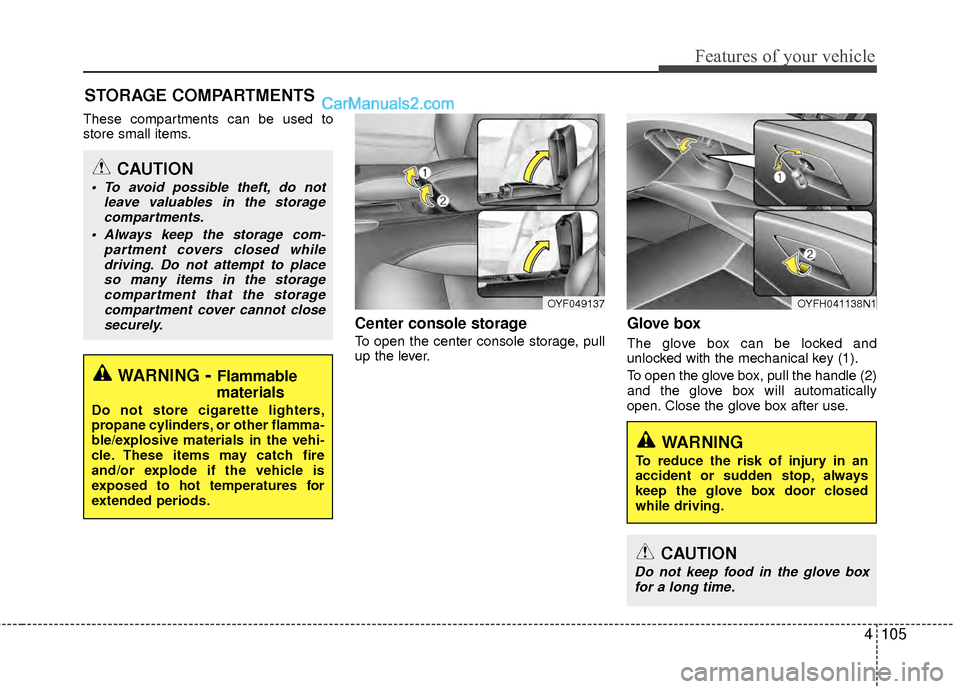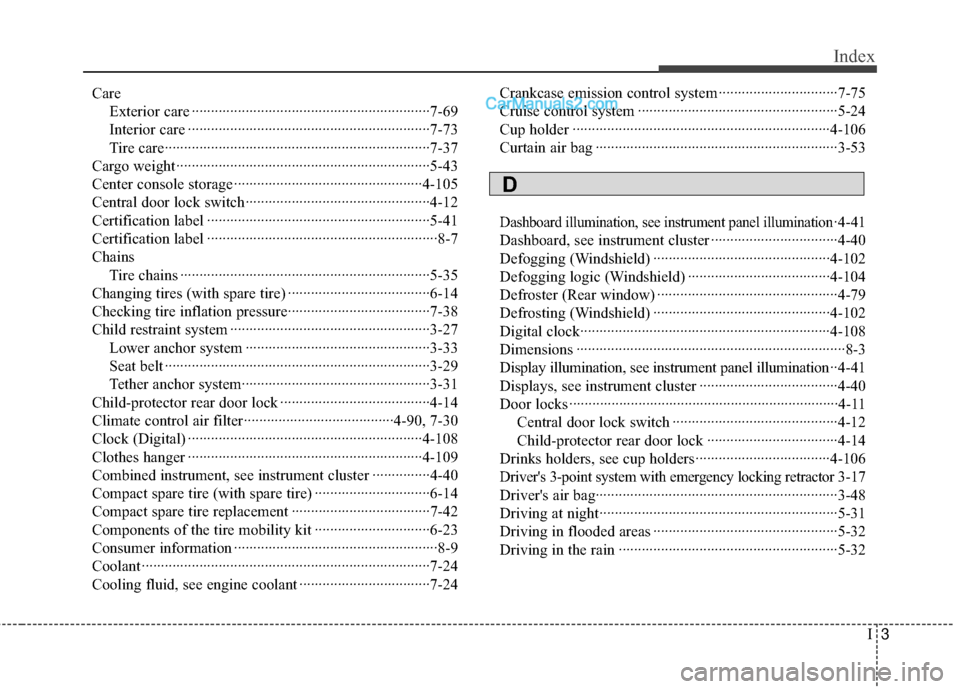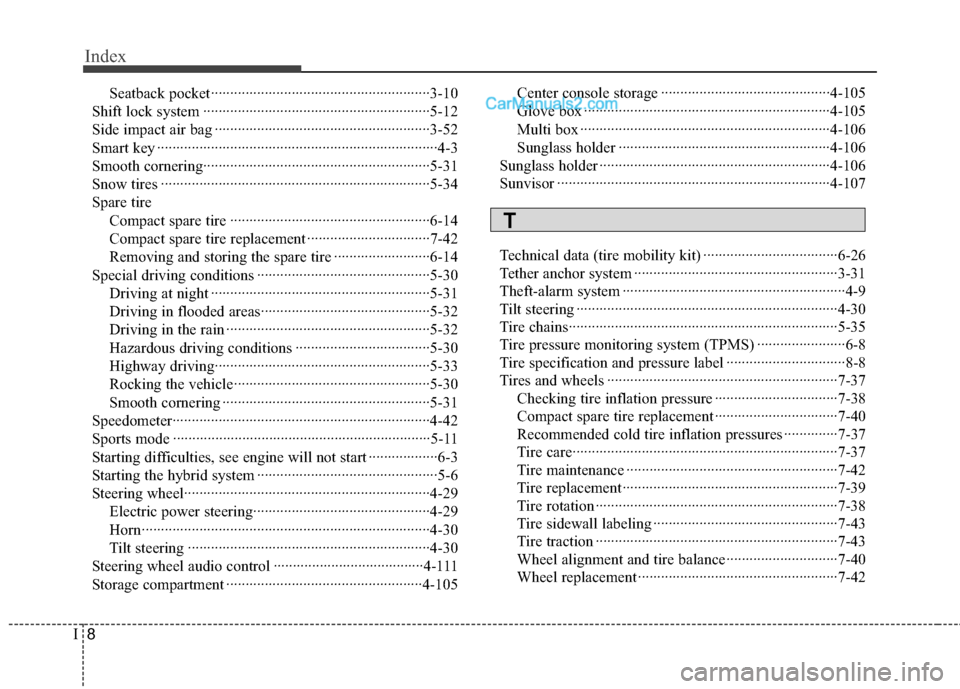2012 Hyundai Sonata Hybrid center console
[x] Cancel search: center consolePage 62 of 403

343
Safety features of your vehicle
Main components of occupant
classification system
A detection device located within thefront passenger seat frame.
Electronic system to determine whether the front passenger air bag system
should be activated or deactivated.
A warning light located on the instru- ment panel which illuminates the words
PASS AIR BAG "OFF" indicating the
front passenger air bag system is deac-
tivated.
The instrument panel air bag warning light is interconnected with the occupant
classification system.
If the front passenger seat is occupied by
a person that the system determines to be
of adult size, and he/she sits properly (sit-
ting upright with the seatback in an upright
position, centered on the seat cushion
with their seat belt on, legs comfortably
extended and their feet on the floor), the
PASS AIR BAG "OFF" indicator will be
turned off and the front passenger's air
bag will be able to inflate, if necessary, in
frontal crashes. You will find the PASS AIR BAG "OFF"
indicator on the center facia panel. This
system detects the conditions 1~4 in the
following table and activates or deacti-
vates the front passenger air bag based
on these conditions.
Always be sure that you and all vehicle
occupants are seated and restrained
properly (sitting upright with the seat in
an upright position, centered on the seat
cushion, with the person's legs comfort-
ably extended, feet on the floor, and
wearing the safety belt properly) for the
most effective protection by the air bag
and the safety belt.
The OCS may not function properly if
the passenger takes actions which can
affect the classification system. These
include:
(1) Failing to sit in an upright position.
(2) Leaning against the door or center console.
(3) Sitting towards the sides or the front of the seat.
(4) Putting legs on the dashboard or resting them on other locations
which reduce the passenger weight
on the front seat.
(5) Improperly wearing the safety belt.
(6) Reclining the seat back.
Page 64 of 403

345
Safety features of your vehicle
1KMN3663
1KMN3664
1KMN3665
- Never sit with hips shiftedtowards the front of the seat.
- Never lean on the door or centerconsole.
- Never sit on one side of the front passenger seat.
- Never place feet on the dash-
board.
OVQ036013N
1KMN3662
- Never put a heavy load in thefront passenger seat or seatback
pocket.
- Never excessively recline thefront passenger seatback.
OVQ036014N
- Never place feet on the front pas-senger seatback.
(Continued)
Page 66 of 403

347
Safety features of your vehicle
(Continued)
Do not place an electronic devicesuch as a laptop computer on the
front passenger seat. Its elec-
tronic field may cause the OCS to
switch to the "on" condition and
thus allow the passenger air bag
to deploy needlessly in a colli-
sion, increasing your repair
costs.
A smaller-stature adult in the front passenger’s seat who is not
seated correctly (for example:
seat excessively reclined, leaning
on the door or center console, or
hips shifted forward in the seat)
can cause a condition where the
occupant classification system
senses less weight than if the
occupant were seated properly
(sitting upright with the seatback
in an upright position, centered
on the seat cushion with their
seat belt on, legs comfortably
extended and their feet on the
floor).
This condition can result in an
adult potentially being misclassi-
fied as a child and illumination of
the PASS AIR BAG "OFF" indica-
tor.(Continued)
Accident statistics show thatchildren are safer if they are
restrained in the rear, as opposed
to the front seat. It is recom-
mended that child restraints be
secured in a rear seat, including
an infant riding in a rear-facing
infant seat, a child riding in a for-
ward-facing child seat and an
older child riding in a booster
seat.
Air bags can only be used once – have an authorized HYUNDAI
dealer replace the air bag imme-
diately after deployment.
The occupant classification sys- tem may not work properly if
water, coffee or any other liquid
including rain gets on the seat.
Keep the front seat dry at all
times.
(Continued)(Continued)
If the PASS AIR BAG "OFF" indi-cator is illuminated when the
front passenger's seat is occu-
pied by an adult and he/she sits
properly (sitting upright with the
seatback in an upright position,
centered on the seat cushion
with their seat belt on, legs com-
fortably extended and their feet
on the floor), have that person sit
in the rear seat.
Do not modify or replace the front passenger seat. Don't place any-
thing on or attach anything such
as a blanket or seat heater to the
front passenger seat. This can
adversely affect the occupant
classification system.
Do not sit on sharp objects such as tools when occupying the
front passenger seat. This can
adversely affect the occupant
classification system.
Do not use accessory seat cov- ers on the front seats.
(Continued)
Page 69 of 403

Safety features of your vehicle
50
3
✽
✽
NOTICE
• Be sure to read information about the
SRS on the labels provided on the sun
visor.
• Advanced air bags are combined with pre-tensioner seat belts to help pro-
vide enhanced occupant protection in
frontal crashes. Front air bags are not
intended to deploy in collisions in
which protection can be provided by
the pre-tensioner seat belt.
(Continued)
Move your seat as far back as
practical from the front air bags,
while still maintaining control of
the vehicle.
You and your passengers should never sit or lean unnecessarily
close to the air bags. Improperly
positioned driver and passengers
can be severely injured by inflat-
ing air bags.
Never lean against the door or center console – always sit in an
upright position.
Do not allow an adult passenger to ride in the front seat when the
PASS AIR BAG "OFF" indicator is
illuminated, because the air bag
will not deploy in the event of a
moderate or severe frontal crash.
(Continued)WARNING
Always use seat belts and child
restraints – every trip, every time,
everyone! Air bags inflate with con-
siderable force and in the blink of
an eye. Seat belts help keep occu-
pants in proper position to obtain
maximum benefit from the air bag.
Even with advanced air bags,
improperly and unbelted occupants
can be severely injured when the
air bag inflates. Always follow the
precautions about seat belts, air
bags and occupant safety con-
tained in this manual.
To reduce the chance of serious or
fatal injuries and receive the maxi-
mum safety benefit from your
restraint system:
Never place a child in any child orbooster seat in the front seat.
ABC – Always Buckle Children in the back seat. It is the safest
place for children of any age to
ride.
Front and side air bags can injure occupants improperly positioned
in the front seats.
(Continued)
WARNING
If you are considering modification
of your vehicle due to a disability,
please contact the Hyundai
Customer Assistance Center at 1-
800-633-5151.
Page 186 of 403

4105
Features of your vehicle
These compartments can be used to
store small items.
Center console storage
To open the center console storage, pull
up the lever.
Glove box
The glove box can be locked and
unlocked with the mechanical key (1).
To open the glove box, pull the handle (2)
and the glove box will automatically
open. Close the glove box after use.
STORAGE COMPARTMENTS
WARNING- Flammable
materials
Do not store cigarette lighters,
propane cylinders, or other flamma-
ble/explosive materials in the vehi-
cle. These items may catch fire
and/or explode if the vehicle is
exposed to hot temperatures for
extended periods.
CAUTION
To avoid possible theft, do not
leave valuables in the storagecompartments.
Always keep the storage com- partment covers closed whiledriving. Do not attempt to placeso many items in the storage compartment that the storagecompartment cover cannot closesecurely.
OYFH041138N1OYF049137
WARNING
To reduce the risk of injury in an
accident or sudden stop, always
keep the glove box door closed
while driving.
CAUTION
Do not keep food in the glove boxfor a long time.
Page 397 of 403

I3
Index
Care Exterior care ··················\
··················\
··················\
········7-69
Interior care ··················\
··················\
··················\
·········7-73
Tire care··················\
··················\
··················\
···············7-37
Cargo weight ··················\
··················\
··················\
············5-43
Center console storage ··················\
··················\
·············4-105
Central door lock switch··················\
··················\
············4-12
Certification label ··················\
··················\
··················\
····5-41
Certification label ··················\
··················\
··················\
······8-7
Chains Tire chains ··················\
··················\
··················\
···········5-35
Changing tires (with spare tire) ··················\
··················\
·6-14
Checking tire inflation pressure··················\
··················\
·7-38
Child restraint system ··················\
··················\
················3-27 Lower anchor system ··················\
··················\
············3-33
Seat belt ··················\
··················\
··················\
···············3-29
Tether anchor system··················\
··················\
·············3-31
Child-protector rear door lock ··················\
··················\
···4-14
Climate control air filter··················\
··················\
···4-90, 7-30
Clock (Digital) ··················\
··················\
··················\
·······4-108
Clothes hanger ··················\
··················\
··················\
·······4-109
Combined instrument, see instrument cluster ···············4-40
Compact spare tire (with spare tire) ··················\
············6-14
Compact spare tire replacement ··················\
··················\
7-42
Components of the tire mobility kit ··················\
············6-23
Consumer information ··················\
··················\
·················8-9
Coolant ··················\
··················\
··················\
··················\
···7-24
Cooling fluid, see engine coolant ··················\
················7-24 Crankcase emission control system ··················\
·············7-75
Cruise control system ··················\
··················\
················5-24
Cup holder ··················\
··················\
··················\
·············4-106
Curtain air bag ··················\
··················\
··················\
·········3-53
Dashboard illumination, see instrument panel illumination·4-41
Dashboard, see instrument cluster ··················\
···············4-40
Defogging (Windshield) ··················\
··················\
··········4-102
Defogging logic (Windshield) ··················\
··················\
·4-104
Defroster (Rear window) ··················\
··················\
···········4-79
Defrosting (Windshield) ··················\
··················\
··········4-102
Digital clock··················\
··················\
··················\
···········4-108
Dimensions ··················\
··················\
··················\
················8-3
Display illumination, see instrument panel illumination ··4-41
Displays, see instrument cluster ··················\
··················\
4-40
Door locks ··················\
··················\
··················\
················4-11 Central door lock switch ··················\
··················\
·······4-12
Child-protector rear door lock ··················\
················4-14
Drinks holders, see cup holders··················\
·················4-10\
6
Driver's 3-point system with emergency locking retractor3-17
Driver's air bag··············\
··················\
··················\
·············3-48
Driving at night··················\
··················\
··················\
········5-31
Driving in flooded areas ··················\
··················\
············5-32
Driving in the rain ··················\
··················\
··················\
···5-32
D
Page 402 of 403

Index
8I
Seatback pocket··················\
··················\
··················\
···3-10
Shift lock system ··················\
··················\
··················\
·····5-12
Side impact air bag ··················\
··················\
··················\
··3-52
Smart key ··················\
··················\
··················\
··················\
·4-3
Smooth cornering··················\
··················\
··················\
·····5-31
Snow tires ··················\
··················\
··················\
················5-34
Spare tire Compact spare tire ··················\
··················\
················6-14
Compact spare tire replacement ··················\
··············7-42
Removing and storing the spare tire ··················\
·······6-14
Special driving conditions ··················\
··················\
·········5-30 Driving at night ··················\
··················\
··················\
···5-31
Driving in flooded areas··················\
··················\
········5-32
Driving in the rain ··················\
··················\
·················5-32\
Hazardous driving conditions ··················\
·················5-30\
Highway driving··················\
··················\
··················\
··5-33
Rocking the vehicle··················\
··················\
···············5-30
Smooth cornering ··················\
··················\
··················\
5-31
Speedometer··················\
··················\
··················\
·············4-42
Sports mode ··················\
··················\
··················\
·············5-11
Starting difficulties, see engine will not start ··················\
6-3
Starting the hybrid system ··················\
··················\
···········5-6
Steering wheel···············\
··················\
··················\
·············4-29 Electric power steering··················\
··················\
··········4-29
Horn··················\
··················\
··················\
··················\
···4-30
Tilt steering ··················\
··················\
··················\
·········4-30
Steering wheel audio control ··················\
··················\
···4-111
Storage compartment ··················\
··················\
···············4-105 Center console storage ··················\
··················\
········4-105
Glove box ··················\
··················\
··················\
··········4-105
Multi box ··················\
··················\
··················\
···········4-106
Sunglass holder ··················\
··················\
··················\
·4-106
Sunglass holder ··················\
··················\
··················\
······4-106
Sunvisor ··················\
··················\
··················\
·················4-10\
7
Technical data (tire mobility kit) ··················\
·················6-26\
Tether anchor system ··················\
··················\
·················3-31\
Theft-alarm system ··················\
··················\
··················\
····4-9
Tilt steering ··················\
··················\
··················\
··············4-30
Tire chains··················\
··················\
··················\
················5-35
Tire pressure monitoring system (TPMS) ··················\
·····6-8
Tire specification and pressure label ··················\
·············8-8
Tires and wheels ··················\
··················\
··················\
······7-37 Checking tire inflation pressure ··················\
··············7-38
Compact spare tire replacement ··················\
··············7-40
Recommended cold tire inflation pressures ··············7-37
Tire care··················\
··················\
··················\
···············7-37
Tire maintenance ··················\
··················\
··················\
·7-42
Tire replacement ··················\
··················\
··················\
··7-39
Tire rotation ··················\
··················\
··················\
·········7-38
Tire sidewall labeling ··················\
··················\
············7-43
Tire traction ··················\
··················\
··················\
·········7-43
Wheel alignment and tire balance ··················\
···········7-40
Wheel replacement ··················\
··················\
················7-42
T